Genetics
The Sociability Spectrum: Evidence from Genetics
Low and high sociability vary according to the diametric model.
Posted June 27, 2020 Reviewed by Kaja Perina
As the authors of a paper in press argue:
Sociability entails some of the most complex behaviors processed by the central nervous system. It includes the detection, integration, and interpretation of social cues and elaboration of context-specific responses that are quintessentially species-specific. There is an ever-growing accumulation of molecular associations to autism spectrum disorders (ASD), from causative genes to endophenotypes across multiple functional layers; these however, have rarely been put in context with the opposite manifestation featured in hypersociability syndromes.
The authors reviewed the use of genetic copy number variations (CNVs) to investigate the relationships between gene dosage and its manifestations in a number of syndromes. In particular, they focussed on CNVs on chromosome 7, “which manifest diametrically opposite social behaviors.” As Crespi, Summers, and Dorus showed in 2009, sufferers from Williams-Beuren Syndrome (WBS) caused by deletion of the q11 region on chromosome 7 are hyper-social, voluble, and are typically diagnosed with a psychotic spectrum disorder (PSD). Those with a duplication of the same region suffer severe language impairment, ASD, and seizures (which often go with ASD).

As their diagram left illustrates, the authors review key evidence of molecular players involved at both ends of the sociability spectrum, focusing on genetic and functional associations of neuroendocrine regulators and synaptic transmission pathways: "We then proceed to propose the existence of a molecular axis centered around the paradigmatic dosage imbalances at the 7q11.23 locus, regulating networks responsible for the development of social behavior in humans and highlight the key role that neurodevelopmental models from reprogrammed pluripotent cells will play for its understanding."
Interestingly in respect of the auto-domestication theory and its implications for ASD and PSD explained in previous posts, a genome-wide association of genetic markers in dogs from 85 breeds compared to 92 gray wolves identified a top-ranking outlier region located within the WBSCR17 gene, which is typically deleted in WBS. A follow-up study found that a genomic marker near the Williams region was under positive selection in domestic dog breeds and that hyper-sociability is a core element of domestication that distinguishes dogs from wolves.

As the authors' diagram above illustrates and the diametric model predicts:
The study of the distribution of sociability in the population shows that its manifestation constitutes a continuous variable fitting a normal (Gaussian) distribution, with most individuals falling in the middle of the range and some individuals exhibiting pathological/abnormal phenotypes, at each tail of the distribution […]. Within this spectrum, the outlier groups make up two categories: 1) at the lower end, hyposociability, which encompasses psychopathic disorders, anxiety and autism spectrum disorders and 2) at the upper end, hypersociability, which includes the pathological need for social contact, emotional dependence on continuous social company and lack of social inhibition.
According to the diametric model, psychotic spectrum disorders such as paranoia show pathological elaboration of "detection, integration, and interpretation of social cues and elaboration of context-specific responses" cited by the authors as entailed in sociability. Indeed, these are manifested in delusions of being watched or spied on, delusions of conspiracy, or the belief that others hate you—or are in love with you in the case of erotomania. As I have mentioned before, psychiatrists since Bleuler have been commenting that, whatever their other deficits might be, some psychotics show occasional astonishing ability to read other people's minds, or intuit their feelings. And as I have argued in previous posts, there are psychotic savants—high functioning psychotics comparable to autistic savants, but with mentalistic rather than mechanistic skills—who owe their success in life to their outstanding social and political skills (examples being Bruno Bettelheim in the USA or Trofim Lysenko in the USSR).
Finally, it is worth adding that there is a normal, population-wide factor which makes much the same point. This is the finding that women are averagely more sociable than men. Generally, females are superior to males in pretend play in childhood; social judgement; and empathy and co-operation. Women exceed men in social expressions such as facial expressiveness; interpretative skill; gazing; smiling; and in expressiveness of body language. [1] Meta-analysis of many different studies shows that women exceed men on measures of anxiety, trust, tender-mindedness, and gregariousness. Indeed, according to the researchers, “These differences are invariant across ages, educational levels, and nations.” [2] And according to another meta-analysis, women make greater social and emotional contributions to small groups than men and are more easily influenced in them. [3] Where sociability within the family is concerned, American women can name more relatives than their husbands, see their relatives more than men, and invest more in them; Canadian sisters recall more relatives than their brothers, especially matri-lateral ones; and Canadian couples with young children see more of the wife’s parents, irrespective of distance. [4] As Charles Murray concludes in his recent review of the literature, "The technical studies tell us that women are, on average, warmer, more sympathetic, more altruistic, and more sensitive to others' feelings than men are." [5]
In other words, if the bell curve of sociability illustrated above were divided on this basis, the female curve would be somewhat offset to the hyper-sociability side and the male somewhat to the hypo-sociability one, just as the imprinted brain theory proposes.
Clearly, there is more to the genetics of sociability than meets the eye!
References
[1] Kimura, D., Sex and Cognition. 2000, Cambridge, MA: MIT Press.
[2] Hall, J., Nonverbal sex differences. 1984, Baltimore: Johns Hopkins.
[3] Eagly, A. Sex Differences in Social Behaviour. 1987, Hillsdale NJ: Erlbaum,
[4] Salmon, Catherine A., and Martin Daly. 1996. On the Importance of Kin Relations to Canadian Women and Men. Ethology and Sociobiology 17:289-97.
[5] Murray, Charles, Human Diversity: The Biology of Gender, Race, and Class. 2020, New York, Twelve.


